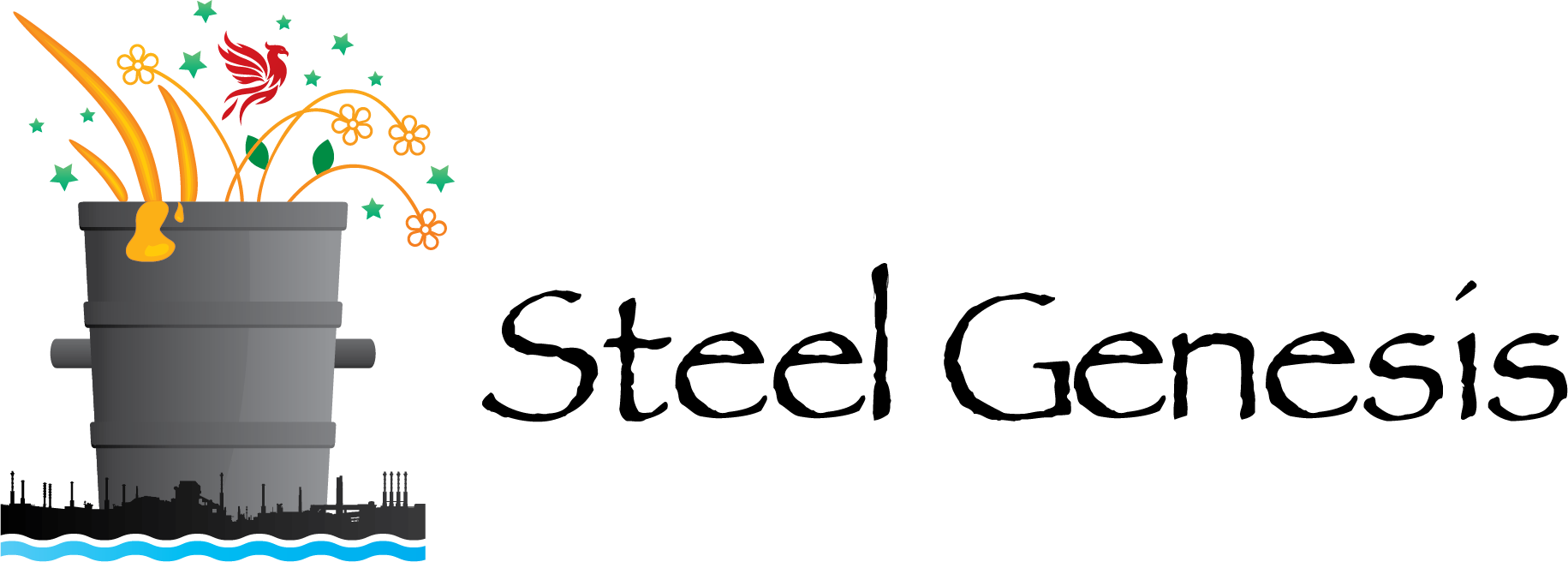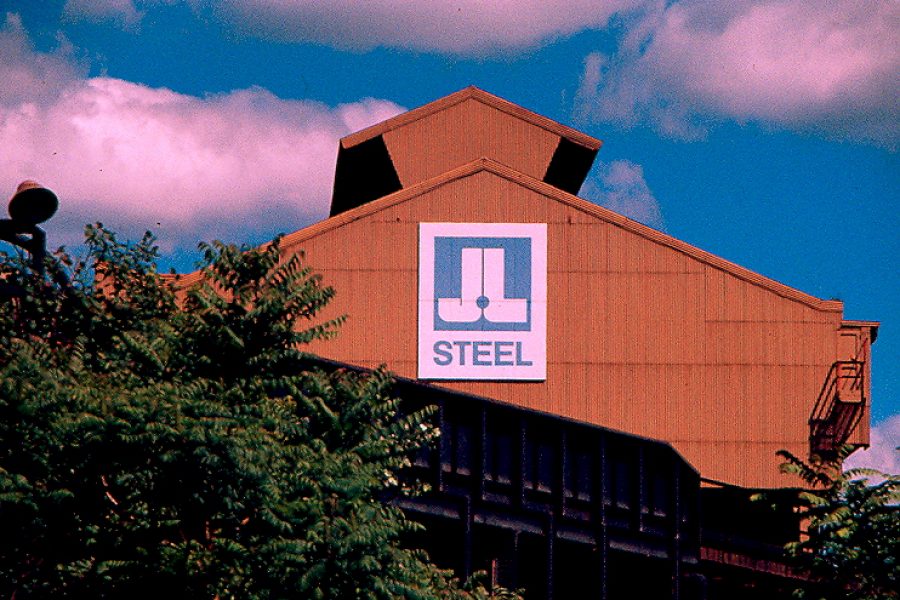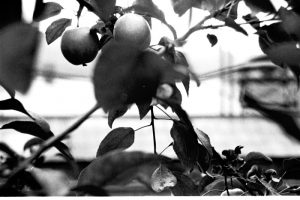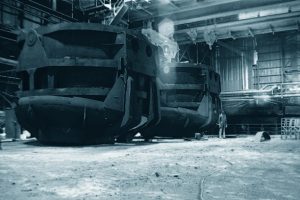The Universe resounds with the joyful cry, I am. –Scriabin
Tap: to pierce in order to draw off liquid … to draw (liquid) from a vessel or container –The American Heritage Dictionary
In 1977, I worked for Frank Rote who supervised construction of Pittsburgh Works’ electric furnaces. When completed, those twin electrics would cook as much steel as the eleven open hearths, and Pittsburgh’s open hearth era would end.
On that late spring morning, I stuffed my feet into hard-toed shoes, pulled into the green fireproof jacket, slipped on protective eyeglasses, fit an orange hard hat on my head and clomped up East Carson Street to the 29th Street Gate.
My new boss and I clomped toward a five-story, three-block metal barn. Below Four Shop’s truck ramp, steelworkers in green asbestos jackets and orange hard hats scurried, hollered and laughed. Forklifts, trucks and tractor trailers rumbled across concrete. Trains clanged. Loudspeakers squawked. Horns blared. Sirens whined. Beyond the wild grasses, blackberry, catalpa, sumac and maple that rimmed the river, tugboats hooted.
Four Shop was a windowless, five-story, three-block barn of corrugated tin. From the Twenty-Ninth Street Gate, it looked like The Works’s other sheds except it was tan instead of black and a half century newer.
On the grounds below Four Shop’s truck ramp, steelworkers in mint green asbestos jackets and orange hard hats walked, most with brisk purpose. They drove fork lifts and trucks of all sizes. Engines thrummed. Horns blared. Loudspeakers squawked. Men hollered. Laughed.
When we reached the steel shop’s western entrance, its huge portal sliced off daylight like a guillotine. Inside, whistles and beeps, rumbles and clangs thickened the cavern’s smoky air. Crunching over cinders and crushed stone, we passed piles of white dolomite and brown magnesite. I gawked as hooks taller than men hoisted buckets big as small houses.
From outside, Four Shop looked like Pittsburgh Works’ other somber, smoky and windowless sheds, except it was taller, longer and newer. Rote and I climbed a steep truck ramp to Four Shop’s charging floor. The huge portal sliced away daylight like a guillotine. Glimmering lights poked through the gloom. Inside, the distant ceiling covered like night. Small beacons flickered through shadow. Whistles and beeps and rumbles and clangs punctured the dust-thickened air.
White dolomite and brown magnesite dunes cluttered the cavernous floor. Paired hooks taller than men hoisted iron buckets bigger than cabins. I breathed sulfur. A persistent thunder shook air that tasted like metal and char. Crunching over crumbled ores, I watched a fifty-foot, clanking dragon ride wide-set rails as its head snatched black tubs and dumped ten thousand pounds of ore into an Open Hearth’s red-orange glare.
Our footsteps crunched as we moved past mounds of ore. Hooks bigger than men and buckets larger than rooms dipped in and out of Four Shop’s darkness. A 70-foot-wide no-man’s land dominated by a clanking dragon called the charging machine separated the ore storage area from the hearths. The charging machine’s horrid head lifted the bathtub-sized ore bins and shoved them into the furnaces. The eleven open hearth furnaces lined up like 60-foot-long shoe boxes. Their walls were three feet of brick with six iron gates that lifted like windows. Inside, the white-orange “bath” simmered.
The eleven, eighty-foot furnaces needed more than eight hours at ninety-five million BTU per hour to melt a half million pounds of molten iron and nearly as much iron scrap, steel scrap, ore, sinter and flux into three thousand cubic feet of steel. Through holes in the furnace’s heavy, iron doors, the fire and brimstone lake – called a “bath” or “heat” – shone eclipse intense. Depending on the carbon-oxygen content, the knee-high brew either lay like a pond, rolled like the ocean or bubbled like tea. Seething limestone trapped impurities in a white satin foam called slag.
A fifty-foot, clanking dragon called the charging machine grabbed huge, iron boxes with its head and shoved them through the open hearth doors, dumping ten thousand pounds of ore into the fire and brimstone lake. It took eight to ten hours at ninety-five million BTu per hour to turn a half million pounds of molten iron, fifty thousand pounds of iron scrap, two hundred thirty-thousand pounds of steel scrap and one hundred thousand pounds of assorted ores, sinter and fluxes into three thousand square feet of molten steel.
I winced at the white-orange glare piercing the five-foot doors. Liquid steel shines too bright for unprotected eyes. Depending on the steel’s chemistry, the knee-high “bath” lay like a pond, rolled like the ocean or bubbled like tea water. Limestone became a bright, white slag that worked like detergent, gurgling down and then suspending phosphorus and sulfur — which make steel brittle — and other impurities. Slag looked like white satin when it overflowed, seething under the doors and over a furnace’s charred “breast.”
The steel inside the furnace was called a “bath” or a “heat.” When finished, the “heat” was tapped or drained. Rote asked a First Helper, one who worked the furnace’s charging or front side, which of the eleven hearths would tap next. Above the clamor and the furnaces’ roars, the man shouted that far off, No. 50 would go in an hour. No. 43 in ten minutes.
A corridor between each furnace led to a narrow ledge above the deep ladle pit. There, we found No. 43’s Second Helpers, the men who worked a furnace’s tap or back side. Assembled like midwives, they wore long, silver coats and hoods with face shields. Waiting, they stamped their high, heavy boots and joked beside the ladle, a two-story, fifteen-foot wide bucket. Third Helpers worked both sides of the furnace
On that narrow platform, below the hissing No. 43, Second Helpers assembled like midwives. They wore long, silver coats and hoods with face shields. Waiting, they stamped their high, heavy boots and swapped jokes on that cliff above the ladle pit.
Steel poured best at 2,900 degrees Fahrenheit. Molten steel always “chewed,” gouging its crucible. When too hot, it gnawed through the furnace’s three-foot-thick, high-chromium, corrosion-resistant brick. “Oh, I’ve seen some pretty spectacular break outs in the open hearths,” beamed Tom Williams, a steel Melter. “You’d lose a whole heat right through the bottom! And I mean, when it comes through, it probably took maybe, I’d say, a furnace would empty out in sixty seconds,” ten times faster than a controlled tap. Steel overheated by just one hundred degrees could also cook through the iron and brick “ladle,” the two-story, fifteen-foot wide bucket that carried sloshing steel to the ingot molds. If renegade steel found damp earth or, worse, puddles, tons of superheated metal erupted like water in boiling oil, mutilating and killing.
The boss, the Melter — he alone — decided when the struggle to bring iron, carbon, sulfur and molybdenum into a delicate harmony was won …
when the quarter-million dollar bath was ready to be born
when to hold that steel any longer would endanger that furnace …
when the Melter said,
“Tap that son of a bitch.”
Ten minutes before tap, a shrill whistle warned workers from the broad pit. Crane operators – hovering above the ladle and slag pot with those giant hooks – glided upriver. Another horn summoned helpers from nearby furnaces. They traveled down a brick-paved passage that sloped to a narrow ledge. There, Second Helpers – those who birthed the steel – assembled like midwives. Waiting, they shimmered in long, silver coats and hoods with face shields. They stamped their high, heavy boots and joked beside the ladle nestled in its deep pit.
Nothing about Tom Williams distinguished him as “The Melter.” He wore the same smudged, asbestos jacket and pants as other steelworkers. Beneath his orange hard hat, Tom’s ruddy face and dark eyes were alert. He moved with athletic robustness.
The jet tapper, an explosive charge, rested atop a ten-foot pole. At tap time, a shrill whistle warned ladle cranemen hovering overhead and people down in the pit to clear away while another whistle summoned Helpers from nearby furnaces.
The eight-inch wide by four-inch high tap hole banked six feet upwards and was packed with dolomite. When detonated, the jet tapper’s nozzle plunged up that channel while. The ten-foot insertion pole shot backwards, sailing into the vast teeming aisle. Once a pin prick opened, the steel chewed its way down from the furnace, a trickle fast becoming a flood.
The detonator box was slightly larger than a big man’s fist. But that morning, when the jet exploded — jolting my bones and nearly toppling my hard hat — no bright orange steel burned through the hole, down the spout and into the bucket-like ladle. The Second Helper set another charge, and another. Minutes moved like hours. The steel continued cooking off carbon … simmering toward value-less scrap metal …… getting hotter … right above us. Water pipes cooling the furnace hissed. The air at 43 furnace was grim.
Years later, Frank Goldcamp told me, “No Melter worth his salt is gonna let a heat be scrapped because he didn’t have enough manpower to get the job done.” True to that tradition, Tom Williams relieved the Second Helpers and donned the shining silver coat, the gauntlets and boots. He lowered the heavy face shield, grasped an oxygen lance and shoved that tubing up the dolomite. When oxygen collided with the intense furnace temperature, fire billowed high and wide around him.
After a while, Williams stopped, lifted the face shield, wiped his face and ordered another explosion. When the passage again remained dim, Williams pulled down the face shield, put on the gloves and leaned his body into that trench, shoving oxygen toward his steel.
Far away, No. 50 furnace delivered. Light from its filling ladle warmed the brooding, canyon-like walls. The rising steel circle looked like the sun as it thrust rapiers of light into Four Shop’s vast teeming aisle. Fireworks erupted. Signal bells and gongs hooted and shrieked. But at No. 43 furnace, most who had come to watch the bright spectacle of a tap disappeared. In the glare from the oxygen lance’s fire, those who remained were nervously watchful.
The No. 43 furnace crew set off seven jet tappers before a fine orange-yellow thread trickled, then flowed, then filled the spout, then kicked and shot off radiant sprays as 350 tons of blinding orange liquid danced into the ladle. When the crane gently lifted that volcanic brew and cradled it across the pit to the ingot moulds, steelworkers’ faces gleamed like No. 43’s vast and distant dark walls, reflecting the newborn steel.
Photo (c) Sandra Gould Ford
Image: Four Shop’s western portal
Originally published in Carnegie Magazine.








